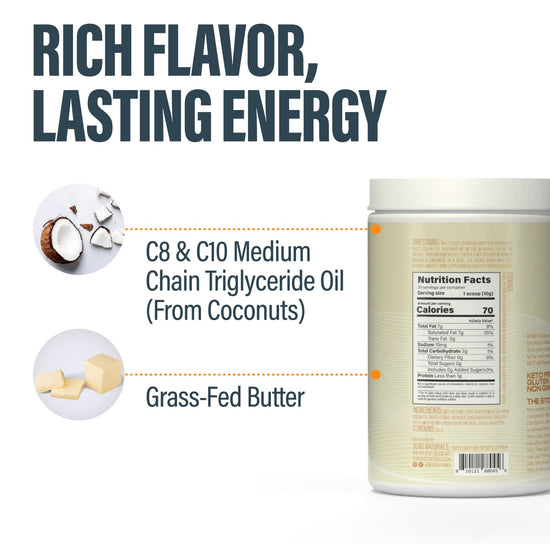Table of Contents
- Introduction
- The Basics of Coffee Creamer
- The Evolution of Coffee Creamer
- Exploring Different Types of Coffee Creamers
- Making Healthier Choices with Coffee Creamer
- Conclusion
- FAQ
Introduction
Every morning, millions of us reach for a bottle or packet of coffee creamer, blissfully unaware of the intricate blend of ingredients that transforms our regular cup of coffee into a creamy, flavorful experience. Have you ever paused to think about what is actually in coffee creamer? The truth is, coffee creamer has evolved significantly since its inception, offering a wide variety of options that cater to diverse dietary needs and taste preferences.
Coffee creamer first appeared on the market in the mid-20th century, initially designed as a convenient alternative to milk or cream for those who sought a lactose-free option. Today, it is ubiquitous in homes, offices, and cafes across the country, available in both liquid and powdered forms. But what exactly are we adding to our cups when we opt for coffee creamer? This blog post aims to peel back the layers and explore the various components, types, and considerations surrounding this popular coffee additive.
By the end of this article, you will have a clear understanding of what is in coffee creamer, how it’s made, the differences between various types, and even some healthier alternatives. Together, we’ll embark on this journey to demystify coffee creamer, ensuring that you can make informed choices for your morning brew.
The Basics of Coffee Creamer
What Is Coffee Creamer?
Coffee creamer is a non-dairy or dairy product that serves the purpose of enhancing the flavor and texture of coffee. It is available in various forms, such as liquid, powder, and even single-serving pods. The main goal of coffee creamer is to replicate the creamy mouthfeel that traditional dairy cream would provide but often with added flavorings, sweeteners, and stabilizers.
Historically, coffee creamer emerged in the 1950s as consumers began looking for alternatives to milk that could withstand shelf life and be more convenient. The first commercial coffee creamer was developed in 1950, and since then, the market has exploded with flavors ranging from vanilla to salted caramel.
Types of Coffee Creamer
Coffee creamers can generally be classified into two main categories: dairy-based and non-dairy. Each type has its own unique composition and target audience.
-
Dairy-Based Creamers: These often include milk, cream, or half-and-half as their primary ingredients, providing a rich and authentic taste. However, they do require refrigeration and have a shorter shelf life compared to non-dairy options.
-
Non-Dairy Creamers: These are typically made from various vegetable oils (like coconut or palm oil), sugar, and stabilizers. Many non-dairy creamers are marketed as lactose-free, making them suitable for those with lactose intolerance. However, it’s important to note that some non-dairy creamers may still contain sodium caseinate, a milk derivative, which may not be acceptable for strict vegans.
Ingredients Overview
So, what is in coffee creamer? Let’s break down some of the common ingredients found in both dairy and non-dairy creamers.
Primary Ingredients
-
Vegetable Oil: This is often the main ingredient in non-dairy creamers. It provides the creamy texture that consumers expect without the use of dairy. Common sources include palm oil, coconut oil, and soybean oil.
-
Corn Syrup and Sugars: Many creamers are sweetened with corn syrup or other sugars to enhance flavor. This can increase the calorie content, so it's essential to check the nutrition label if you're monitoring your intake.
-
Sodium Caseinate: As mentioned, this is a milk protein that helps stabilize the creamer. While it’s a common ingredient in many non-dairy creamers, it can be misleading for those who avoid dairy entirely.
-
Flavorings: Coffee creamers come in an array of flavors, from classic vanilla to seasonal pumpkin spice. These flavorings are often artificial but can also be derived from natural sources.
-
Emulsifiers and Stabilizers: Ingredients like mono- and diglycerides or carrageenan are added to help maintain the texture and prevent separation.
Nutritional Considerations
When evaluating coffee creamers, it’s crucial to consider their nutritional value. Many commercial brands have lower-fat or sugar-free versions available. However, these options may still contain artificial sweeteners or other additives that some consumers prefer to avoid.
For those who prioritize clean eating, it's worth exploring brands that focus on minimal and recognizable ingredients. At BUBS Naturals, we believe in a clean and simple approach to wellness, which includes being mindful of what we put in our bodies, even in our morning coffee.
The Evolution of Coffee Creamer
Historical Context
The journey of coffee creamer began in the 1940s, led by pioneers who sought to create a shelf-stable alternative to dairy. Holton "Rex" Diamond's experiments with soybean protein during World War II paved the way for what would eventually become non-dairy creamers. The commercialization of these products began in earnest in the 1950s, with brands like Coffee-Mate launching in 1961, setting the standard for the market.
As consumer preferences evolved, so did the formulations. Today, we see a plethora of options catering to dietary restrictions and flavor preferences, from vegan creamers made from almond or oat milk to indulgent creamers infused with flavors like hazelnut and caramel.
The Rise of Health-Conscious Options
In recent years, there has been a growing trend toward health-conscious products. Many consumers are now scrutinizing ingredient lists more closely, leading brands to develop cleaner, more transparent formulations. This has resulted in a surge of organic, gluten-free, and non-GMO creamers hitting the shelves.
Impact on Coffee Culture
Coffee creamer has significantly influenced coffee culture, particularly in America. The rise of flavored creamers has led to an entire subculture of coffee enthusiasts who experiment with different combinations to create personalized brews. This trend has also sparked a dialogue about the balance between flavor and health, prompting many to seek out alternatives that align with their wellness goals.
Exploring Different Types of Coffee Creamers
Liquid Creamers
Liquid creamers are perhaps the most common type, found in both dairy and non-dairy forms. They are typically used in coffee shops and households alike.
Dairy Liquid Creamers
These options include traditional cream, half-and-half, and whole milk. They provide a rich flavor profile and are often favored for their natural taste. However, they do require refrigeration and have a shorter shelf life.
Non-Dairy Liquid Creamers
These creamers are often made from vegetable oils, sugars, and stabilizers. They are shelf-stable, making them a convenient option for those who prefer non-dairy products. However, as noted earlier, some may contain sodium caseinate, which is important for consumers to consider.
Powdered Creamers
Powdered creamers offer a longer shelf life and do not require refrigeration, making them ideal for travel or office use.
Dairy Powdered Creamers
These may contain dehydrated milk or cream and are often used in places where refrigeration is not available. While they may lack the richness of liquid creamers, they are convenient for on-the-go coffee lovers.
Non-Dairy Powdered Creamers
These are made from hydrogenated oils, sugars, and stabilizers. They provide a creamy texture when mixed with hot coffee but may be less favorable for those seeking a clean ingredient list.
Specialty Creamers
With the rise of consumer interest in unique flavors and dietary needs, specialty creamers have gained popularity. These may include:
-
Plant-Based Creamers: Made from almonds, soy, coconut, or oats, these options cater to those looking for dairy-free alternatives.
-
Flavored Creamers: From seasonal pumpkin spice to chocolate mint, flavored creamers allow consumers to personalize their coffee experience.
-
Low-Calorie or Sugar-Free Creamers: These options often use artificial sweeteners and provide a guilt-free indulgence for those watching their caloric intake.
Making Healthier Choices with Coffee Creamer
Why It Matters
Understanding what is in coffee creamer is essential for making informed dietary choices. Many conventional creamers are laden with sugars, artificial additives, and unhealthy fats. By opting for healthier alternatives, we can enhance our coffee experience without compromising our wellness goals.
Tips for Choosing Healthier Creamers
-
Read the Ingredient List: Look for creamers with minimal, recognizable ingredients. Avoid those with long lists of additives or artificial flavors.
-
Watch the Sugar Content: Some creamers can contain high amounts of sugar. If you enjoy sweetness in your coffee, consider using natural sweeteners or reducing the amount of creamer you use.
-
Explore Plant-Based Options: If you’re lactose intolerant or seeking a dairy-free lifestyle, explore plant-based creamers made from nuts or oats. These can offer a creamy texture without dairy.
-
Try Making Your Own: For those who enjoy DIY projects, homemade coffee creamers can be a great way to control ingredients. Simple recipes using almond milk or coconut milk combined with vanilla or other natural flavors can be both delicious and healthy.
-
Consider BUBS Naturals Products: At BUBS Naturals, we celebrate clean, natural ingredients. While we don’t offer coffee creamers, our other products, like our MCT Oil Powder, can be great additions to your coffee for a boost of sustained energy and mental clarity without the additives.
Conclusion
By now, you should have a comprehensive understanding of what is in coffee creamer and the various options available to you. From its historical evolution to the myriad choices in the market today, coffee creamer has transcended its humble beginnings to become a staple in many coffee drinkers' routines.
As we navigate our wellness journeys, it’s essential to be mindful of the ingredients we choose to add to our diets. Whether you prefer traditional dairy creamers or explore the diverse world of non-dairy options, knowing what you’re consuming can help you make choices that align with your health goals.
As a final thought, consider your coffee routine. Are you satisfied with your current creamer, or is it time to explore healthier options? Remember, at BUBS Naturals, we believe in the power of simplicity—a single scoop can make a difference, whether in your coffee or your overall wellness journey.
FAQ
What is coffee creamer made of?
Coffee creamer is typically made from vegetable oils, sugars, and stabilizers, with some options containing milk derivatives like sodium caseinate.
Is coffee creamer dairy-free?
Not all coffee creamers are dairy-free. While many non-dairy creamers exist, some may still contain milk proteins. Always check the ingredient label.
How long does coffee creamer last?
Liquid coffee creamers usually have a shorter shelf life than powdered creamers. Non-dairy liquid creamers can last up to a month after their best-by date, while powdered creamers can last several months if stored properly.
Can I make my own coffee creamer?
Yes! Homemade coffee creamers can be made using simple ingredients like almond milk or coconut milk, along with natural flavorings like vanilla or cocoa powder.
What are some healthier alternatives to coffee creamer?
Healthier alternatives include plant-based creamers, homemade options, or using MCT Oil Powder for a clean energy boost without added sugars or artificial ingredients.
By understanding what is in coffee creamer, we can make choices that align with our health and wellness aspirations. Here’s to many more enjoyable coffee moments ahead!
Written by:

Butter MCT Oil Creamer
BUBS Butter MCT Oil Creamer (formerly Halo Creamer): Scientifically-Backed Brain and Body Fuel
BUBS Butter MCT Oil Creamer is your go-to for clean, fast-acting energy and focus, no crash included. It blends creamy grass-fed butter with fast-acting MCT oil powder (C8 and C10) to kickstart your day and keep you sharp. The MCTs go straight to work, giving your brain a quick boost while the grass-fed butter supports digestion and gut health.
Together, they help curb cravings, keep you feeling full longer, and support steady energy throughout the day—perfect for fueling your mornings or powering through the afternoon slump.
Starts at $36.00
Shop

